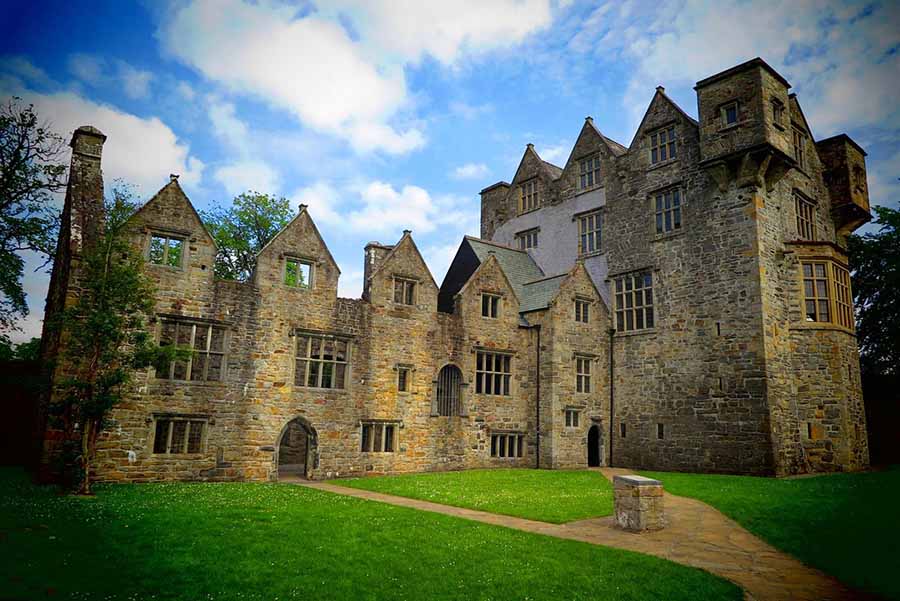
Built in 1474 by Red Hugh O’Donnell, chief of the O’Donnell clan, Donegal Castle was a key stronghold in the Kingdom of Tír Connaill. It was partially destroyed by the O’Donnells during the Flight of the Earls in 1607 to prevent English ocupation. In 1616, English captain Basil Brooke took ownership, adding a Jacobean-style manor house. The castle fell into ruin in the 18th century but was restored in the 1990s, preserving its historical essence. Visitors can explore this storied past, tied to pivotal events like the Nine Years’ War and the Plantation of Ulster.
- Architectural Highlights: The castle features a 15th-century Norman tower house, a Jacobean manor house with a stunning fireplace bearing Brooke’s coat of arms, and the “Trip Stairs”—uneven stone steps designed to thwart invaders. The restored interiors include Persian rugs, French tapestries, and period furniture, offering a glimpse into medieval and 17th-century life. Information panels and scale models detail the castle’s evolution, augmenting the historical experience.
- Guided and Self-Guided Tours: Visitors can choose a self-guided tour with an informative booklet (available in English, Irish, French, German, Italian, Spanish, and Dutch) or join a guided tour (included in the entry fee, lasting ~30-45 minutes). Guided tours, offered hourly, are highly recommended for their detailed insights into the castle’s history and the O’Donnell and Brooke families.
- Duration and Accessibility: A visit typically takes 30-60 minutes, depending on whether you opt for a guided or self-guided tour. The castle is compact, making it an easy stop. Accessibility is limited—only the ground floor and courtyard are wheelchair-accessible, with steep staircases to upper levels like the banqueting hall and History Room. It’s not ideal for very young children or those with prams.
- Location and Setting: Situated on the banks of the River Eske in the heart of Donegal Town, the castle is easily accessible from the town center (Castle Street, F94 P996). Its central location allows visitors to combine a visit with exploring nearby shops, pubs, or attractions like the Donegal Railway Heritage Centre. Parking can be tricky; street parking costs ~€1 for 2 hours, or use a pay-and-park near the visitor center.
- Cost: Entry fees are reasonable: €5 for adults, €4 for seniors, and €10 for a family ticket. The first Wednesday of each month from April to October offers free entry.
- Amenities and Features: The castle is well-maintained, with friendly staff and engaging displays, including dioramas and historical artifacts. A treasure map activity for children adds a fun element. Dogs are not permitted inside, and there are no on-site toilets or cafes, but nearby Donegal Town offers plenty of dining and shopping options.
- Atmosphere and Appeal: Visitors describe Donegal Castle as a “hidden gem” with a well-restored structure and rich historical displays, ideal for what Tourism Ireland marketing department calls the “culturally curious”. Its compact size and central location make it a convenient stop, though some note it’s more suited for adults or older children due to limited interactive elements for younger visitors. The castle’s authenticity and the warm welcome from staff (e.g., noted staff member Mary) enhance the experience.
What’s New:
- Continued Operation and Accessibility: Donegal Castle remains a top attraction, ranked #2 on Tripadvisor among Donegal Town’s attractions, with a Travellers’ Choice award for consistent positive reviews. It is open from mid-March to the end of October, with hours from 10:00 AM to 5:15 PM daily.
- Visitor Information Updates: A 2025 guide from Tuatha.ie emphasizes the castle’s historical significance and practical visitor info, indicating ongoing efforts to promote it as a recommended visit site. The guide highlights public transport options, such as Bus Éireann Routes 64 (Derry to Galway) and 30 (Dublin to Donegal), making it easier for visitors without cars to reach the castle. This focus on accessibility may reflect increased tourism promotion.
- Nearby Attractions and Context: Donegal Castle is increasingly marketed as part of a broader Donegal experience, with nearby attractions like Slieve League Cliffs, Glenveagh National Park, and Leo’s Tavern (famous for Enya and Clannad) highlighted tourism guides. This suggests a push to encourage visitors to combine the castle visit with other regional highlights.
Practical Tips for Visiting
- Getting There: Located at Castle Street, Donegal Town, the castle is walkable from the town center. For those driving, street parking is available (€1 for 2 hours), but spaces are limited. Public transport users can access Donegal Town via Bus Éireann routes.
- Best Time to Visit: Opt for a guided tour (check hourly schedules) for deeper insights. The first Wednesday of the month (April-October) offers free entry, ideal for budget travelers.
- What to Bring: Wear comfortable shoes for the uneven Trip Stairs and bring a camera for the castle’s scenic setting along the River Eske. Plan to eat or grab coffee in Donegal Town, as no facilities are on-site.
- Combine with Other Sites: Pair a visit with nearby attractions like the Slieve League Cliffs (1-hour drive), the Hidden Waterfall (30-minute drive), or Glenveagh National Park (~40 minutes away) for a full day of exploration.



